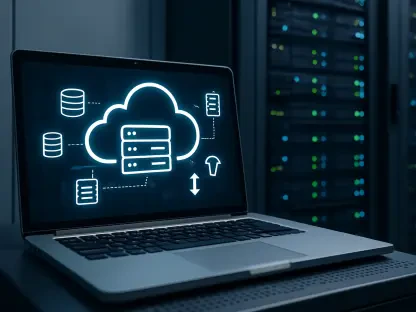The recent allegations of a significant data breach in Oracle Cloud have instigated considerable controversy and an exhaustive investigation. This cybersecurity incident reportedly affects millions of records and numerous Oracle Cloud tenants, casting a spotlight on cloud security and the measures necessary to safeguard sensitive information. The situation has created a sharp divide between Oracle’s official stance and the findings of a cybersecurity firm, posing substantial questions about modern cyber threats and response strategies.
Allegations of a Major Cyberattack
Extent of the Alleged Breach
The allegations presented by the cybersecurity firm CloudSEK suggest a substantial breach, with 6 million records compromised, affecting more than 140,000 Oracle Cloud tenants. The breach is purportedly attributed to a hacker identified as “rose87168,” who allegedly exploited vulnerabilities in Oracle’s Single Sign-On (SSO) and Lightweight Directory Access Protocol (LDAP) systems, particularly targeting Oracle WebLogic Server. The compromised data reportedly includes encrypted credentials, key files, and Java KeyStore (JKS) files, creating a high-stakes situation for all involved.
CloudSEK has declared the threat level as “High” due to the scale and sensitivity of the data involved, urging Oracle Cloud users to take immediate action. The firm advised users to reset credentials, conduct thorough forensic investigations, monitor dark web activities for any signs of their data, and enhance access control measures. These recommendations aim to mitigate the risk of further data exposure and prevent potential misuse of the compromised information. Despite these precautions, the potential consequences of the breach remain significant, with the attacker purportedly seeking payment for the removal of the listed data.
Oracle’s Response and Denial
In response to the allegations, Oracle has firmly denied any breach of its cloud systems. A company spokesperson emphasized that the published credentials were not linked to Oracle Cloud and stated unequivocally that no data was compromised. Oracle maintains that their cloud infrastructure remains secure and that the claims of a breach are unfounded. This position, however, is complicated by the attacker’s continued online presence and claims.
The hacker “rose87168” has posted evidence on cybercrime forums, showcasing what they claim to be stolen Oracle data. This evidence includes screenshots and files supposedly taken from Oracle systems, raising questions among the cybersecurity community. Investigations indicate that an older version of Oracle Fusion Middleware, which is vulnerable to CVE-2021-35587, might have been in use. Though this has not been confirmed, it adds yet another layer of complexity to the ongoing controversy and the investigation process.
The Attack and Its Implications
Hacker’s Demands and Threats
The attacker behind the breach has made bold demands and threats, heightening the urgency of the situation. The hacker has demanded $200 million in cryptocurrency in exchange for revealing the details of the breach and assisting in decrypting the stolen credentials. Additionally, they have offered to remove specific data in return for payment, a proposal that adds another layer of risk for the affected organizations. These demands highlight the severe implications for businesses reliant on Oracle Cloud for their data storage and management.
The attacker’s demands paint a dire picture for the victims of the breach. The prospect of having to negotiate with a cybercriminal to regain control over sensitive data is a daunting challenge for any organization. The potential financial and reputational damages are significant, and the situation underscores the importance of robust cybersecurity measures and rapid response strategies. This scenario serves as a stark reminder of the evolving landscape of cyber threats and the need for continuous vigilance.
Uncertain Future and Continuing Investigation
As the investigation continues, the full extent and authenticity of the data breach remain uncertain. Oracle’s official stance denies any breach, while CloudSEK continues to assert the serious risks associated with the potentially leaked data. This divide within the cybersecurity community reflects the broader challenges in verifying and addressing cyber threats. The ongoing investigation seeks to uncover the truth and provide clarity to affected parties and the industry at large.
The investigation into the breach is a complex and multifaceted process. It involves collaboration between cybersecurity experts, law enforcement agencies, and the affected organizations. The goal is to identify the vulnerability exploited by the attacker, assess the full scope of the data compromised, and implement measures to prevent future incidents. This ongoing effort highlights the dynamic nature of cybersecurity and the constant need to adapt to new threats.
Oracle Cloud User Recommendations
Immediate Actions for Users
Given the allegations and the potential risks involved, Oracle Cloud users are urged to take immediate and proactive measures to safeguard their data. CloudSEK’s recommendations include resetting credentials, conducting forensic investigations, and monitoring the dark web for any signs of leaked data. These steps are essential to mitigate the potential damage and prevent further exposure. Enhancing access control measures and implementing multi-factor authentication are also critical components of a robust cybersecurity strategy.
Taking immediate action is crucial for Oracle Cloud users to protect their data and maintain trust with their customers. Resetting credentials ensures that compromised information cannot be used to gain unauthorized access. Conducting forensic investigations helps identify any signs of a breach and provides valuable insights into the attacker’s methods. Monitoring the dark web for leaked data enables organizations to stay ahead of potential threats and take appropriate measures to prevent misuse of their information.
Long-term Security Measures
Beyond immediate actions, Oracle Cloud users must consider long-term security measures to protect against future threats. This includes regularly updating and patching software to address known vulnerabilities, implementing comprehensive security policies, and conducting regular security audits. Staying informed about the latest cybersecurity trends and threats is also essential to adapt to the evolving landscape. Investing in employee training and awareness programs is crucial to ensure that all staff members are equipped to recognize and respond to potential security threats.
Long-term security measures are essential for building a resilient and secure cloud environment. Regular software updates and patches help close potential vulnerabilities that cybercriminals could exploit. Comprehensive security policies ensure that all aspects of the organization’s operations are protected, while regular audits help identify and address any weaknesses in the security infrastructure. Staying informed about the latest threats and trends allows organizations to adapt their strategies and stay ahead of cybercriminals.
Key Takeaways and Future Considerations
Summary of Key Points
In conclusion, the reported cyberattack targeting Oracle Cloud has sparked significant controversy and investigation within the cybersecurity community. CloudSEK alleges a major breach involving 6 million records and affecting over 140,000 tenants, while Oracle firmly denies any compromise of its systems. The attacker’s demands for a substantial ransom and the potential risks for affected organizations underscore the importance of robust cybersecurity measures.
The investigation into the breach remains ongoing, with experts working to uncover the truth and provide clarity to the affected parties. Oracle Cloud users are advised to take immediate actions to safeguard their data and consider long-term security measures to protect against future threats. The evolving landscape of cyber threats requires continuous vigilance and adaptive strategies to stay ahead of potential risks.
Preparing for Future Threats
Recent allegations about a substantial data breach in Oracle Cloud have generated significant controversy and launched a thorough investigation. This cybersecurity issue reportedly impacts millions of records and numerous Oracle Cloud tenants, drawing attention to cloud security and the necessary measures to protect sensitive information effectively. The incident has sparked a pronounced discrepancy between Oracle’s official statements and the findings of cybersecurity firms, leading to considerable questions regarding contemporary cyber threats and appropriate response strategies. Experts are now debating the efficacy and robustness of cloud security protocols and Oracle’s handling of the breach. This situation underscores the growing concerns in the digital landscape about safeguarding data and the critical importance of keen vigilance and responsive measures. Cybersecurity professionals emphasize the necessity for more advanced defenses against increasingly sophisticated attacks, urging organizations to enhance their security frameworks to prevent future breaches.









